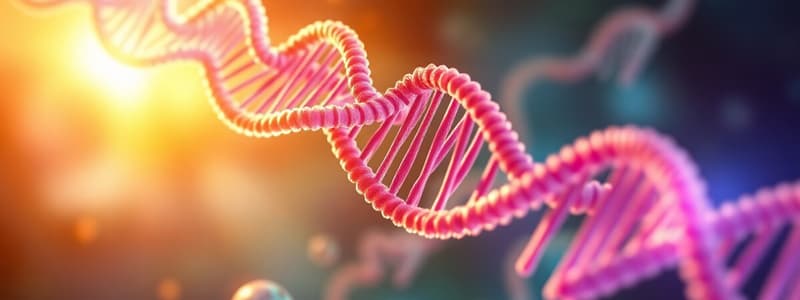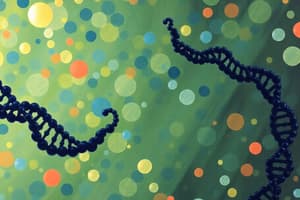Podcast
Questions and Answers
What is the primary function of hnRNP in the processing of pre-mRNA?
What is the primary function of hnRNP in the processing of pre-mRNA?
- Preventing folding of pre-mRNA into secondary structures (correct)
- Enhancing the binding of RNA polymerase
- Facilitating RNA editing mechanisms
- Degrading unprocessed mRNA molecules
Which of the following is part of the pre-mRNA processing steps for eukaryotic mRNA?
Which of the following is part of the pre-mRNA processing steps for eukaryotic mRNA?
- Transcription
- Replication
- Translation
- 5’ Capping (correct)
What does the term hnRNA refer to?
What does the term hnRNA refer to?
- Fully processed mRNA ready for translation
- A variety of non-coding RNA molecules
- Heterogeneous nuclear RNA, including pre-mRNA and other nuclear RNAs (correct)
- Only pre-mRNA associated with proteins
Which statement accurately describes pre-mRNA molecules?
Which statement accurately describes pre-mRNA molecules?
What is the key outcome of 3’ Polyadenylation during pre-mRNA processing?
What is the key outcome of 3’ Polyadenylation during pre-mRNA processing?
What is the main purpose of trans-splicing in eukaryotes?
What is the main purpose of trans-splicing in eukaryotes?
What are isoforms?
What are isoforms?
In which cellular organelle does RNA editing most commonly occur in higher eukaryotes?
In which cellular organelle does RNA editing most commonly occur in higher eukaryotes?
What role do RNA-binding proteins play in alternative splicing?
What role do RNA-binding proteins play in alternative splicing?
What is a characteristic of ribozymes?
What is a characteristic of ribozymes?
Which of the following is true regarding the fibronectin gene?
Which of the following is true regarding the fibronectin gene?
What are group II self-splicing introns associated with?
What are group II self-splicing introns associated with?
What is the primary function of Nuclear Pore Complexes (NPCs)?
What is the primary function of Nuclear Pore Complexes (NPCs)?
How are the membranes of the nuclear envelope structured?
How are the membranes of the nuclear envelope structured?
What type of molecules are primarily transported through the Nuclear Pore Complexes?
What type of molecules are primarily transported through the Nuclear Pore Complexes?
What is a fundamental characteristic of FG nucleoporins in the Nuclear Pore Complex?
What is a fundamental characteristic of FG nucleoporins in the Nuclear Pore Complex?
What signals proteins synthesized in the cytosol to enter the nucleus?
What signals proteins synthesized in the cytosol to enter the nucleus?
What role do importins play in nuclear transport?
What role do importins play in nuclear transport?
Which component is NOT part of the structure of the Nuclear Pore Complex?
Which component is NOT part of the structure of the Nuclear Pore Complex?
What is the effect of fusing a nuclear-localization signal (NLS) to a cytoplasmic protein?
What is the effect of fusing a nuclear-localization signal (NLS) to a cytoplasmic protein?
Which statement accurately describes the bidirectional transport facilitated by Nuclear Pore Complexes?
Which statement accurately describes the bidirectional transport facilitated by Nuclear Pore Complexes?
What is the primary role of the 7-methylguanylate cap added to the 5’ end of pre-mRNA?
What is the primary role of the 7-methylguanylate cap added to the 5’ end of pre-mRNA?
Which protein complex is primarily responsible for polyadenylation of pre-mRNA?
Which protein complex is primarily responsible for polyadenylation of pre-mRNA?
What specific structure is formed when the intron is removed during RNA splicing?
What specific structure is formed when the intron is removed during RNA splicing?
What are the conserved sequences required at intron/exon junctions for RNA splicing?
What are the conserved sequences required at intron/exon junctions for RNA splicing?
What is the primary function of the small nuclear ribonucleoprotein particles (snRNPs) in splicing?
What is the primary function of the small nuclear ribonucleoprotein particles (snRNPs) in splicing?
During RNA splicing, what happens to U1 and U4 snRNAs after splicing takes place?
During RNA splicing, what happens to U1 and U4 snRNAs after splicing takes place?
What does the phosphorylation of the C-terminal domain (CTD) of RNA polymerase II indicate?
What does the phosphorylation of the C-terminal domain (CTD) of RNA polymerase II indicate?
What is the maximum number of adenine residues that can be added to the 3’ end of mRNA during polyadenylation?
What is the maximum number of adenine residues that can be added to the 3’ end of mRNA during polyadenylation?
Which of the following is NOT a part of the spliceosome complex?
Which of the following is NOT a part of the spliceosome complex?
What is the purpose of adding a poly(A) tail to mRNA?
What is the purpose of adding a poly(A) tail to mRNA?
What is the role of importin in nuclear import?
What is the role of importin in nuclear import?
What triggers the release of cargo from importin in the nucleoplasm?
What triggers the release of cargo from importin in the nucleoplasm?
Which function does exportin serve in the nuclear export process?
Which function does exportin serve in the nuclear export process?
What do all proteins that shuttle between the nucleus and cytoplasm need to possess?
What do all proteins that shuttle between the nucleus and cytoplasm need to possess?
What is the role of GEF in the GTP switch mechanism?
What is the role of GEF in the GTP switch mechanism?
What is the primary distinction between GTP and GDP in the context of GTP switch proteins?
What is the primary distinction between GTP and GDP in the context of GTP switch proteins?
What happens to exportin after it exports a cargo protein?
What happens to exportin after it exports a cargo protein?
What is the function of mRNA exporter proteins in the nuclear transport process?
What is the function of mRNA exporter proteins in the nuclear transport process?
What does the hydrolysis of Ran-GTP facilitate during the export process?
What does the hydrolysis of Ran-GTP facilitate during the export process?
What role do FG-nucleoporins play in the transport process through nuclear pores?
What role do FG-nucleoporins play in the transport process through nuclear pores?
Flashcards
Pre-mRNA Processing
Pre-mRNA Processing
Eukaryotic pre-mRNA is modified in the nucleus before it leaves for the cytoplasm.
5' Capping
5' Capping
A modification added to the 5' end of pre-mRNA.
3' Polyadenylation
3' Polyadenylation
Adding a tail of adenine nucleotides to the 3' end of pre-mRNA.
Intron Removal & Exon Splicing
Intron Removal & Exon Splicing
Signup and view all the flashcards
hnRNP (heterogeneous nuclear ribonucleoprotein)
hnRNP (heterogeneous nuclear ribonucleoprotein)
Signup and view all the flashcards
Nuclear Pore Complex (NPC)
Nuclear Pore Complex (NPC)
Signup and view all the flashcards
Bidirectional Transport
Bidirectional Transport
Signup and view all the flashcards
Passive Diffusion
Passive Diffusion
Signup and view all the flashcards
Selective Transport
Selective Transport
Signup and view all the flashcards
FG Nucleoporins
FG Nucleoporins
Signup and view all the flashcards
Nuclear Localization Signal (NLS)
Nuclear Localization Signal (NLS)
Signup and view all the flashcards
Importins
Importins
Signup and view all the flashcards
How does a protein enter the nucleus?
How does a protein enter the nucleus?
Signup and view all the flashcards
Trans-Splicing
Trans-Splicing
Signup and view all the flashcards
Alternative Splicing
Alternative Splicing
Signup and view all the flashcards
Isoforms
Isoforms
Signup and view all the flashcards
RNA Editing
RNA Editing
Signup and view all the flashcards
Apo-B pre-mRNA Editing
Apo-B pre-mRNA Editing
Signup and view all the flashcards
Ribozymes
Ribozymes
Signup and view all the flashcards
Group I and II Self-Splicing Introns
Group I and II Self-Splicing Introns
Signup and view all the flashcards
Peptidyl Transferase Activity
Peptidyl Transferase Activity
Signup and view all the flashcards
5' cap
5' cap
Signup and view all the flashcards
5' capping purpose
5' capping purpose
Signup and view all the flashcards
Capping enzyme localization
Capping enzyme localization
Signup and view all the flashcards
Why only RNA polymerase II?
Why only RNA polymerase II?
Signup and view all the flashcards
Polyadenylation complex
Polyadenylation complex
Signup and view all the flashcards
Polyadenylation steps
Polyadenylation steps
Signup and view all the flashcards
Polyadenylation purpose
Polyadenylation purpose
Signup and view all the flashcards
Splice sites
Splice sites
Signup and view all the flashcards
Splice site location
Splice site location
Signup and view all the flashcards
Splice site sequence
Splice site sequence
Signup and view all the flashcards
Nuclear Import
Nuclear Import
Signup and view all the flashcards
Nuclear Export
Nuclear Export
Signup and view all the flashcards
Nuclear Export Signal (NES)
Nuclear Export Signal (NES)
Signup and view all the flashcards
Ran-GTP
Ran-GTP
Signup and view all the flashcards
mRNP
mRNP
Signup and view all the flashcards
mRNA Exporter
mRNA Exporter
Signup and view all the flashcards
Study Notes
Post-Transcriptional Gene Control
- Most RNAs are processed in the nucleus, from primary transcripts, before export to the cytoplasm.
- Locations of various mechanisms are important to note, including types of RNA polymerases and RNA.
- Eukaryotic premature mRNA transcript synthesis occurs by RNA polymerase II, and is processed in three steps.
Pre-mRNA Processing
- 5' capping: occurs shortly after RNA polymerase II initiates transcription, involves adding a 7-methylguanylate cap to the 5' end of the transcript.
- It protects the 5' end from enzymatic degradation and assists mRNA export.
- 3' polyadenylation: a large multi-protein complex forms around the poly(A) signals in pre-mRNA, specifically cleaves the pre-mRNA at a poly(A) site.
- The complex adds up to 250 A residues and protects the 3' end from enzymatic degradation.
- Intron removal and exon splicing: introns are removed, and exons are joined, generally at every exon/intron junction.
Pre-mRNA & hnRNP
- pre-mRNA: nascent mRNA transcripts of protein-coding genes that are always associated with proteins.
- hnRNA: heterogeneous nuclear RNA, includes pre-mRNA and other nuclear RNAs which are complexed with RNA-binding proteins.
- hnRNP: Heterogeneous ribonucleoprotein particles, combination of hnRNA and proteins. (hnRNA is associated with an abundant set of nuclear proteins that contain conserved RNA-binding domains)
hnRNP Functions
- Prevents pre-mRNA forming secondary structures to inhibit interactions with other proteins.
- Presents a more uniform substrate for processing steps such as splicing.
- Involved in transport of mRNA from the nucleus to cytoplasm by associating to cytoplasmic proteins.
5' Capping
- 7-methylguanylate cap is added to the 5' end; first couple ribonucleotides are methylated; the linkage is 5'-5'.
- Protect the 5' end from degradation.
- Aid in export to cytosol.
- Capping enzyme associates with phosphorylated CTD of RNA polymerase II; only RNA polymerase II transcripts are capped.
Polyadenylation
- Large multi-protein cleavage/polyadenylation complex forms around the poly(A) signals in pre-mRNA.
- Cleavage of primary pre-mRNA at poly(A) site produces a free 3' OH.
- Poly(A) polymerase adds up to 250 A residues to the 3' end for protection from degradation.
RNA Splicing
- Introns are removed; exons are joined.
- Intron removal generally occurs at exon/intron junctions.
- Splicing requires conserved sequences at each end of every intron (both the 5' splice site and the 3' splice site).
- Specific nucleotides at the splice sites (G-U @ 5', A @ Branch point) are invariant.
RNA Splicing Mechanism
- snRNPs (5 U-rich small nuclear RNAs): U1, U2, U4, U5, U6 participate in splicing.
- Spliceosome is a large ribonucleoprotein complex of snRNPs assembling on the pre-mRNA to catalyze splicing.
- U1 participates in base pairing with the 5' splice site; U2 interacts with the sequence around the Branch point A.
RNA Splicing Mechanism cont.
- Transesterification reaction: excision of circular lariat intron.
- Exons are ligated together.
- Debranching enzyme converts lariat intron to linear form.
- Nuclear exonucleases cut linear intron.
- Resulting nucleotides are recycled.
Trans-Splicing
- Functional mature mRNAs are derived from processing a single pre-mRNA via cis-splicing, in most eukaryotes.
- Trans-splicing is a special form of RNA processing in eukaryotes, constructing a mature mRNA from multiple different primary RNA transcripts.
- Exons are ligated to form complete molecules.
- Examples: C. elegans, Trypanosomes, and Euglenoids.
Alternative Splicing
- The same pre-mRNA is processed differently in different cells, leading to splicing of different exons from the same gene.
- Different combinations of exons lead to protein isoforms.
- This process is regulated by RNA-binding proteins that bind specific sequences near splice sites.
RNA Editing
- Exon nucleotides are altered prior to mature mRNA production.
- This changes the pre-mRNA sequence in the nucleus and results in differences in the sequence of the corresponding mature mRNA to the genome sequence.
- A particular example is mammalian RNA editing of the apo-B pre-mRNA.
Ribozymes
- Ribozymes are RNA molecules that have catalytic activity.
- 23S and 28S rRNAs of ribosomes have peptidyl transferase activity.
- Group I and II self-splicing introns exist in rRNA and protein-coding genes (most often in rRNA genes in some protozoans and in mitochondrial and chloroplast genes in fungi and plants).
Transport Across the Nuclear Membrane
- The nucleus is surrounded by two membranes.
- Nuclear Pore Complexes (NPCs) allow molecules of all sizes to enter and exit.
- Small molecules and ions diffuse passively through the NPC.
- Larger molecules use energy-dependent transport mediated by RNA molecules.
Nuclear Pore Complex Structure
- NPCs are composed of nucleoporins, attached to nuclear baskets, and cytoplasmic filaments on the cytoplasmic side, and central transporters in the middle.
FG Nucleoporins and Transporters
- FG nucleoporins contain many short hydrophobic FG repeats and long hydrophilic regions.
- Nuclear transporters have hydrophobic regions that bind reversibly to FG domains in FG nucleoporins.
- FG nucleoporins create a molecular sieve that allows small, soluble molecules to pass but not larger molecules.
Import into the Nucleus
- Proteins destined for the nucleus contain a nuclear localization signal (NLS).
- Importins are transport proteins binding to the NLS and carrying cargo into the nucleus.
Mechanism for Nuclear Import
- Free cytosolic importin binds to NLS of cargo protein.
- The complex moves through nuclear pore complexes interacting with nucleoporins.
- Inside the nucleus, conformation change in importin occurs resulting in lower affinity for the NLS of cargo protein causing release.
- Transporters recycle.
Export out of the Nucleus
- Similar mechanism to import: involved exportins, nuclear export signals (NES), and Ran-GTP.
- Proteins, tRNAs, ribosomal subunits move out of the nucleus into the cytoplasm.
- Dissociation of the complex from exportin occurs after Ran-GTP hydrolysis.
- Transporters are recycled. (Ran is a G protein that interacts with Nuclear Pore Complexes during import/export).
Summary: Import & Export of Proteins through NPC
- Cargo proteins contain nuclear localization signals (NLS) or nuclear export signals (NES).
- Some proteins shuttle, and must contain both NLS and NES.
- Import and export both rely on Ran (a G protein) which exists in different conformations when bound to GTP or GDP.
GTP Switch Proteins
- Guanine nucleotide-binding proteins switch "on" when GTP is bound, and "off" when GDP is bound.
- GEFs (guanine nucleotide exchange factors) promote GTP binding and GAPs (GTPase activating proteins) promote GTP hydrolysis.
mRNA Transport out of Nucleus
- mRNA exporter proteins direct most mRNA-protein complexes (mRNPs) through nuclear pores.
- mRNA-exporter diffuses through pores and transiently interacts with FG-nucleoporin proteins. (mRNA exporter proteins have three domains, a domain that binds to mRNPs, a domain that binds to FG nucleoporins, and a C-terminal domain)
Studying That Suits You
Use AI to generate personalized quizzes and flashcards to suit your learning preferences.




